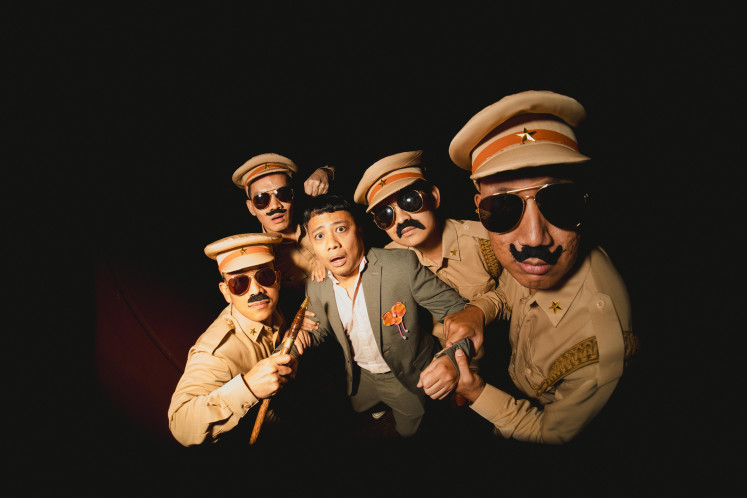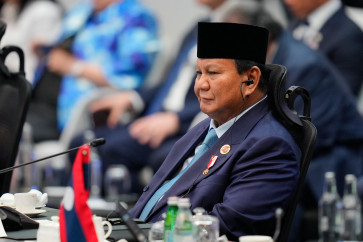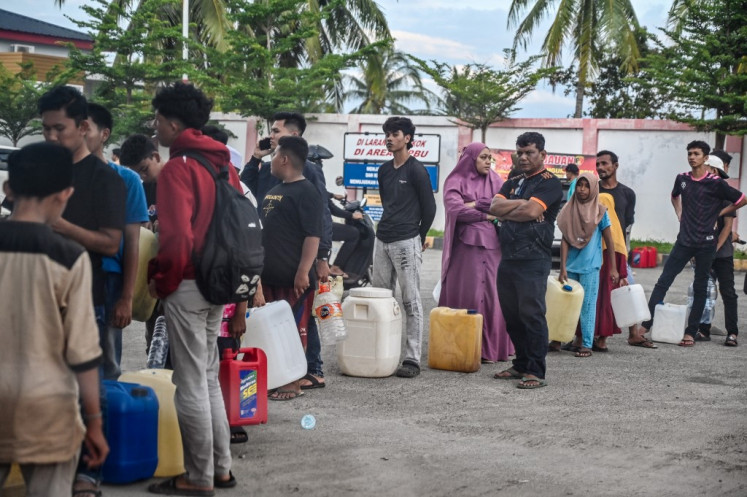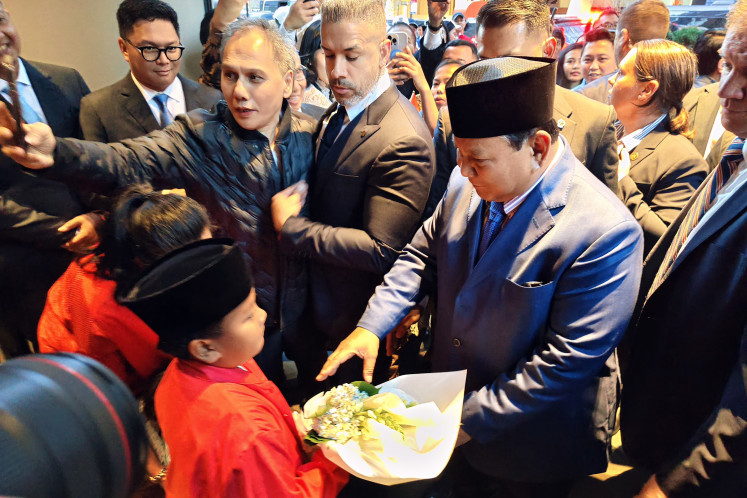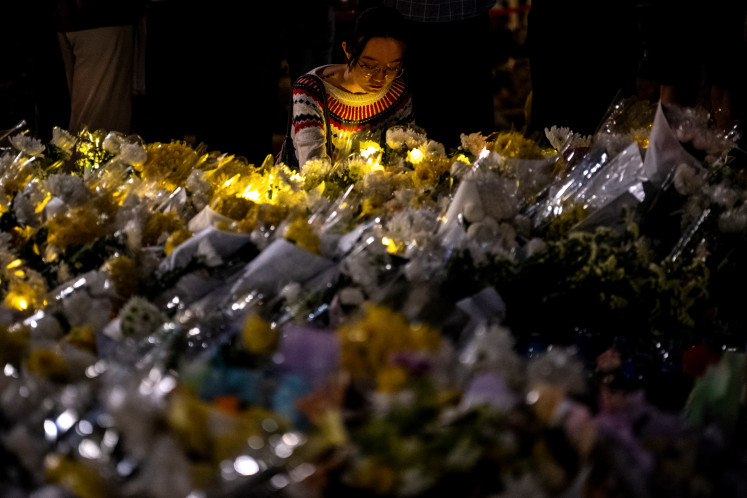Popular Reads
Top Results
Can't find what you're looking for?
View all search resultsPopular Reads
Top Results
Can't find what you're looking for?
View all search resultsTrip to the past: The History of Indonesian Railways
A replica of Jakartaâs Kota station entrance
Change text size
Gift Premium Articles
to Anyone
A replica of Jakarta's Kota station entrance.
The Jakarta-based Erasmus Huis Theater and Gallery in cooperation with Indonesia's train operator, PT Kereta Api Indonesia (KAI), are presenting an informative exhibition entitled 'The History of Indonesian Railways.'
The event, which lasts until Oct. 20, is held as part of the operator's efforts to bring back the railway's glory days for Indonesians.
'The exhibition is made for the public in order to attract people's interest in supporting Indonesian railways,' said KAI president director Ignasius Jonan.
'I personally think that the government and Indonesians have neglected trains for too long. They've chosen to develop road-based transportation, instead.'
The exhibition displays at least 20 replicas of classic steam locomotives; two scale models of railways along with locomotives and their rolling stock; basic tools related to the railway system ' including a field telephone set, telegraphs and tickets, uniforms, railway maps from around Indonesia, certificates as well as black-and-white historical photos that portray the development of Indonesian railways in former times.
The indoor exhibition, which replicates Jakarta's iconic Kota station entrance door, also displays the history of the Lawang Sewu building in Semarang, which was used as the headquarters for Indonesia's first railway company, the Netherlandsch ' Indische Spoorweg Maatschappij (NIS).
PT Kereta Api Indonesia president director Ignasius Jonan (left) explains a diorama of a railway passage beneath Anai valley, West Sumatra.
Outside the display room, the exhibition also showcases two miniature trains ' with one them available for a joy ride around the area.
Indonesia has a long railway history ' dating back to the Dutch colonial era in the archipelago.
'The trains not only connect cities, but also people, because through railways we share a common heritage and history, which I think is important. We [Dutch and Indonesians] have the same DNA, the same railways ' so you get the feeling of being at home,' said Erasmus Huis director Ton van Zeeland.
The development of railways in Indonesia was initiated by the cultivation system (originally known as cultuurstelsel) imposed by the Dutch government in 1830 upon Indonesian natives by Governor General Johannes van den Bosch.
The policy had a positive impact on the growth of plantations in inland areas where coffee, rubber, quinine, cocoa, cotton, nutmeg and pepper, among other commodities, were grown.
The idea to construct a railway network came from Colonel JHR Van der Wijk in 1840. He proposed the Dutch East Indies government build a Jakarta'Surabaya railway line via Surakarta, Yogyakarta and Bandung.
Yet, the final chosen line ended up as Semarang'Surakarta'Yogyakarta because it covered regions that were rich in sugar cane, coffee, tobacco, teak and other wood.
A replica of TD 10 steam locomotive.
In 1862, the Dutch government issued a concession to NIS to build the first railway from Semarang to Tanggung.
Naamlooze Venootschap Nederlandsch Indische Spoorweg Maatschappij (NV. NISM), which was headed by JP de Bordes, initiated the Semarang'Tanggung line, which was 26 kilometers long.
About three years later, the nation's first ever rail line was officially opened.
Samarang'Tanggung'Kedung Jati'Solo'Yogyakarta rail lines were soon completed and started to operate in 1872. A year later, the Semarang'Surakarta'Yogyakarta route, including Kedungjati'Willem I fort in Ambarawa, was officially opened.
Afterward, NIS continued extending the railway to western ' Batavia'Buitenzorg (Jakarta'Bogor) ' and eastern parts of Java in the same year.
Realizing the scale of difficulties faced by NIS, investors lost interest in building railways. Hence, the government was forced to set up a railway company, Staatsspoorwegen (SS), which built the 115-kilometer Surabaya'Pasuruan line in eastern Java, which was inaugurated in 1878.
The railway network in Indonesia between 1864 and 1900 increased rapidly with 25 kilometers built in 1867, and 110 kilometers in 1870.
By 1880, the railways had expanded to 405 kilometers, 1,427-kilometers in 1890 and 3,338 kilometers in 1900.
By 1939, there were 6,811 kilometers of rail track in Indonesia. However, in 1950 the length was reduced to 5,910 kilometers as a result of demolition and removal to Burma during the Second World War.
A diorama of Ambarawa station in Central Java.
The first railway in Sumatra was built in 1879, connecting Port Ule Lhee and Banda Aceh. In Madura, the railways were built from 1898 to 1901 connecting Kamal (Bangkalan) and Kalianget (Sumenep).
Besides Java and Sumatra, Celebes (Sulawesi) also had a line from Makassar to Takalar which operated between 1922 and 1930. Its operation was ended due to high costs during the Great Depression.
Following independence in 1945, Indonesia took over the management of the railway system. Beginning with Djawatan Kereta Api (1950-1963) and several other names along the way, since 1999 Indonesia's railway operator has been known as KAI.
Until now, trains have been among the most favorite modes of public transportation in the country.
Indonesia lost its romantic relationship with trains following to mismanagement of KAI in the years before Jonan took over in early 2009.
Under Jonan's leadership, the operator has had a positive transformation with the introduction of a modernized ticketing system, cleaner and safer trains as well as tidy stations, which has restored the romanticism of rail travel for most Indonesians.
To take care of the country's train and railway heritage, KAI established a Heritage Conservation and Architecture Design division in 2009.




